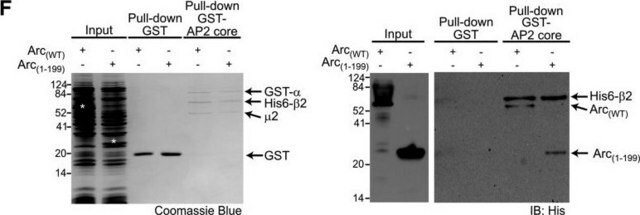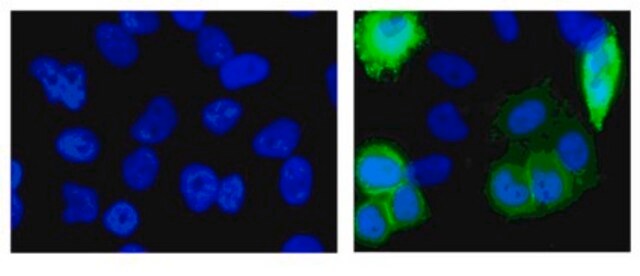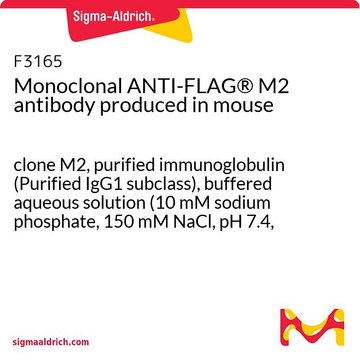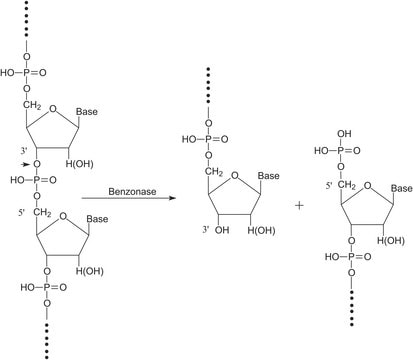11965085001
Roche
Anti-His6-Peroxidase
from mouse IgG1
Sinónimos:
antibody
Iniciar sesiónpara Ver la Fijación de precios por contrato y de la organización
About This Item
UNSPSC Code:
12352203
Productos recomendados
biological source
mouse
Quality Level
conjugate
peroxidase conjugate
antibody form
purified immunoglobulin
antibody product type
primary antibodies
clone
BMG-his-1, monoclonal
form
lyophilized
packaging
pkg of 50 U
manufacturer/tradename
Roche
isotype
IgG1
storage temp.
2-8°C
Categorías relacionadas
General description
Anti-His6-Peroxidase is a monoclonal antibody to His6-tagged proteins, conjugated to horseradish peroxidase. Anti-His6-Peroxidase specifically recognizes an epitope of six consecutive histidine residues of both natural and recombinant proteins. The antibody reacts with native and denatured histidine-tagged fusion proteins independent of the epitope-sequence location; however, it preferentially recognizes the C-terminal His6 epitope with high sensitivity.
Specificity
Anti-His6-Peroxidase specifically recognizes an epitope of six consecutive histidine residues (His6) in natural and recombinant proteins. It reacts with both native and denatured histidine-tagged fusion proteins, independent of location of the epitopesequence. However, Anti-His6-Peroxidase preferentially recognizes the C-terminal His6 epitope with high sensitivity. Anti-His6 allows specific and sensitive detection of histidine-tagged proteins irrespective of the expression system used.
The antibody recognizes an epitope of six consecutive histidine residues (His6) in natural and recombinant proteins. It reacts with both native and denatured histidine-tagged fusion proteins, independent of the epitope-sequence location.
Application
Anti-His6-Peroxidase has been used in in vitro serum stability of fusion toxins, pull-down assay and western blotting.
Anti-His6-Peroxidase is used for the detection of His6-tagged proteins in:
- ELISA (enzyme-linked immunosorbent assay)
- Western blot
Quality
Function test: Western blot using extracts from cell line expressing a recombinant His6-tagged protein.
Preparation Note
Working concentration: Working concentration of conjugate depends on application and substrate.
The following concentrations should be taken as a guideline:
The following concentrations should be taken as a guideline:
- ELISA: 100 mU/ml
- Western blot: 100mU/ml
Reconstitution
Add 1 ml double-distilled water to a final concentration of 50 U/ml.
Reconstitution should be performed for at least 10 minutes.
Reconstitution should be performed for at least 10 minutes.
Other Notes
For life science research only. Not for use in diagnostic procedures.
¿No encuentra el producto adecuado?
Pruebe nuestro Herramienta de selección de productos.
signalword
Warning
hcodes
Hazard Classifications
Skin Sens. 1
Storage Class
11 - Combustible Solids
wgk_germany
WGK 1
flash_point_f
does not flash
flash_point_c
does not flash
Elija entre una de las versiones más recientes:
¿Ya tiene este producto?
Encuentre la documentación para los productos que ha comprado recientemente en la Biblioteca de documentos.
KaiC intersubunit communication facilitates robustness of circadian rhythms in cyanobacteria
Kitayama Y, et al.
Nature Communications, 4 (2013)
Two missense mutations in KCNQ1 cause pituitary hormone deficiency and maternally inherited gingival fibromatosis
Tommiska J, et al.
Nature Communications, 8(1) (2017)
Identification and Characterization of Heptaprenylglyceryl Phosphate Processing Enzymes in Bacillus subtilis
Linde M, et al.
The Journal of Biological Chemistry, 291(28), 14861-14870 (2016)
Manuel Simon et al.
Molecular cancer therapeutics, 13(2), 375-385 (2013-11-05)
Fusion toxins used for cancer-related therapy have demonstrated short circulation half-lives, which impairs tumor localization and, hence, efficacy. Here, we demonstrate that the pharmacokinetics of a fusion toxin composed of a designed ankyrin repeat protein (DARPin) and domain I-truncated Pseudomonas
Nick S Berrow et al.
Nucleic acids research, 35(6), e45-e45 (2007-02-24)
This article describes the construction of a set of versatile expression vectors based on the In-Fusion cloning enzyme and their use for high-throughput cloning and expression screening. Modifications to commonly used vectors rendering them compatible with In-Fusion has produced a
Nuestro equipo de científicos tiene experiencia en todas las áreas de investigación: Ciencias de la vida, Ciencia de los materiales, Síntesis química, Cromatografía, Analítica y muchas otras.
Póngase en contacto con el Servicio técnico









